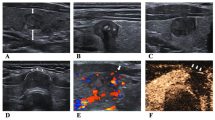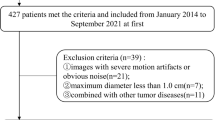Abstract
Objectives
The preoperative classification of pleomorphic adenomas (PMA) and Warthin tumors (WT) in the parotid gland plays an essential role in determining therapeutic strategies. This study aims to develop and validate an ultrasound-based ensemble machine learning (USEML) model, employing nonradiative and noninvasive features to differentiate PMA from WT.
Methods
A total of 203 patients with histologically confirmed PMA or WT who underwent parotidectomy from two centers were enrolled. Clinical factors, ultrasound (US) features, and radiomic features were extracted to develop three types of machine learning model: clinical models, US models, and USEML models. The diagnostic performance of the USEML model, as well as that of physicians based on experience, was evaluated and validated using receiver operating characteristic (ROC) curves in internal and external validation cohorts. DeLong’s test was used for comparisons of AUCs. SHAP values were also utilized to explain the classification model.
Results
The USEML model achieved the highest AUC of 0.891 (95% CI, 0.774–0.961), surpassing the AUCs of both the US (0.847; 95% CI, 0.720–0.932) and clinical (0.814; 95% CI, 0.682–0.908) models. The USEML model also outperformed physicians in both internal and external validation datasets (both p < 0.05). The sensitivity, specificity, negative predictive value, and positive predictive value of the USEML model and physician experience were 89.3%/75.0%, 87.5%/54.2%, 87.5%/65.6%, and 89.3%/65.0%, respectively.
Conclusions
The USEML model, incorporating clinical factors, ultrasound factors, and radiomic features, demonstrated efficient performance in distinguishing PMA from WT in the parotid gland.
Clinical relevance statement
This study developed a machine learning model for preoperative diagnosis of pleomorphic adenoma and Warthin tumor in the parotid gland based on clinical, ultrasound, and radiomic features. Furthermore, it outperformed physicians in an external validation dataset, indicating its potential for clinical application.
Key Points
• Differentiating pleomorphic adenoma (PMA) and Warthin tumor (WT) affects management decisions and is currently done by invasive biopsy.
• Integration of US-radiomic, clinical, and ultrasound findings in a machine learning model results in improved diagnostic accuracy.
• The ultrasound-based ensemble machine learning (USEML) model consistently outperforms physicians, suggesting its potential applicability in clinical settings.






Similar content being viewed by others
Abbreviations
- CI:
-
Confidence interval
- ICC:
-
Inter- and intraclass correlation coefficient
- ML:
-
Machine learning
- OR:
-
Odds ratio
- PMA:
-
Pleomorphic adenoma
- SHAP:
-
SHapley Additive exPlanation
- US:
-
Ultrasound
- USEML:
-
Ultrasound-based ensemble machine learning
- WT:
-
Warthin tumor
References
Sentani KOI, Ozasa K et al (2019) Characteristics of 5015 salivary gland neoplasms registered in the Hiroshima tumor tissue registry over a period of 39 years. J Clin Med 26:566
Xu XXJ, Ling R, Ouyang S et al (2023) Single-cell transcriptomic analysis uncovers the origin and intratumoral heterogeneity of parotid pleomorphic adenoma. Int J Oral Sci 15:38
Skalova A, Hyrcza MD, Leivo I (2022) Update from the 5th Edition of the World Health Organization Classification of Head and Neck Tumors: Salivary Glands. Head Neck Pathol 16:40-53
Lee DH, Yoon TM, Lee JK, Lim SC (2019) Surgical treatment strategy in Warthin tumor of the parotid gland. Braz J Otorhinolaryngol 85:546–550
Yeung DCM, Leung HHS, Lai R et al (2023) A safety and feasibility trial of ultrasound-guided radiofrequency ablation of parotid Warthin’s tumor. Otolaryngol Head Neck Surg. https://doi.org/10.1002/ohn.417
Park S, Lee YC, Lim SJ, Kim C (2023) Malignant transformation of Warthin tumor in the cervical lymph node. Clin Nucl Med 48:342–344
Key S, Chia C, Hasan Z, Sundaresan P, Dwivedi RC, Riffat F (2022) Systematic review of prognostic factors in carcinoma ex pleomorphic adenoma. Oral Oncol 133:106052
Al-Balas H, Metwalli ZA, Eberson S, Sada DM (2021) Clinicopathological features of incidental parotid lesions. Head Face Med 17:10
Huang N, Chen Y, She D, Xing Z, Chen T, Cao D (2022) Diffusion kurtosis imaging and dynamic contrast-enhanced MRI for the differentiation of parotid gland tumors. Eur Radiol 32:2748–2759
Abdel Razek AA, Ashmalla GA, Gaballa G, Nada N (2015) Pilot study of ultrasound parotid imaging reporting and data system (PIRADS): inter-observer agreement Eur J Radiol. 2533-2538
Fisher R, Ronen O (2022) Cytologic diagnosis of parotid gland Warthin tumor: systematic review and meta-analysis. Head Neck 44:2277–2287
Peiffer-Smadja N, Rawson TM, Ahmad R et al (2020) Machine learning for clinical decision support in infectious diseases: a narrative review of current applications. Clin Microbiol Infect 26:584–595
Handelman GS, Kok HK, Chandra RV, Razavi AH, Lee MJ, Asadi H (2018) eDoctor: machine learning and the future of medicine. J Intern Med 284:603–619
Lambin P, Rios-Velazquez E, Leijenaar R et al (2012) Radiomics: extracting more information from medical images using advanced feature analysis. Eur J Cancer 48:441–446
Li Q, Jiang T, Zhang C et al (2022) A nomogram based on clinical information, conventional ultrasound and radiomics improves prediction of malignant parotid gland lesions. Cancer Lett 527:107–114
Al Ajmi E, Forghani B, Reinhold C, Bayat M, Forghani R (2018) Spectral multi-energy CT texture analysis with machine learning for tissue classification: an investigation using classification of benign parotid tumours as a testing paradigm. Eur Radiol 28:2604–2611
Zheng YL, Zheng YN, Li CF et al (2022) Comparison of different machine models based on multi-phase computed tomography radiomic analysis to differentiate parotid basal cell adenoma from pleomorphic adenoma. Front Oncol 12:889833
Feng B, Wang Z, Cui J et al (2023) Distinguishing parotid polymorphic adenoma and Warthin tumor based on the CT radiomics nomogram: a multicenter study. Acad Radiol 30:717–726
Hu Z, Guo J, Feng J, Huang Y, Xu H, Zhou Q (2023) Value of T2-weighted-based radiomics model in distinguishing Warthin tumor from pleomorphic adenoma of the parotid. Eur Radiol 33:4453–4463
Zheng Y, Zhou D, Liu H, Wen M (2022) CT-based radiomics analysis of different machine learning models for differentiating benign and malignant parotid tumors. Eur Radiol 32:6953–6964
Shen XM, Mao L, Yang ZY et al (2022) Deep learning-assisted diagnosis of parotid gland tumors by using contrast-enhanced CT imaging. Oral Dis. https://doi.org/10.1111/odi.14474
Committeri U, Barone S, Salzano G et al (2023) Support tools in the differential diagnosis of salivary gland tumors through inflammatory biomarkers and radiomics metrics: a preliminary study. Cancers (Basel) 15
Chang YJ, Huang TY, Liu YJ, Chung HW, Juan CJ (2021) Classification of parotid gland tumors by using multimodal MRI and deep learning. NMR Biomed 34:e4408
Zheng YM, Li J, Liu S et al (2021) MRI-Based radiomics nomogram for differentiation of benign and malignant lesions of the parotid gland. Eur Radiol 31:4042–4052
Collins GS, Reitsma JB, Altman DG, Moons KG (2015) Transparent reporting of a multivariable prediction model for individual prognosis or diagnosis (TRIPOD): the TRIPOD statement. BMJ 350:g7594
Hernandez-Prera JC (2022) Update from the 5th Edition of the World Health Organization Classification of Head and Neck Tumors: the neck and lymph nodes, metastasis, and melanocytic tumors. Head Neck Pathol 16:110-122
Mentz RJ, Hernandez AF, Berdan LG et al (2016) Good clinical practice guidance and pragmatic clinical trials: balancing the best of both worlds. Circulation 133:872–880
Sultan SR, AlKharaiji M, Rajab SH (2022) Diagnosis of parotid gland tumours with contrast-enhanced ultrasound: a systematic review and meta-analysis. Med Ultrason 24:211–218
Yushkevich P A, Piven J, C HH (2006) User-guided 3D active contour segmentation of anatomical structures: significantly improved efficiency and reliability. Neuroimage 31:1116–1128
van Griethuysen JJM, Fedorov A, Parmar C et al (2017) Computational radiomics system to decode the radiographic phenotype. Cancer Res 77:e104–e107
R V (2018) Pingouin: statistics in Python. Journal of Open Source Software 3:31
Pedregosa F, Varoquaux G, Gramfort A et al (2011) Scikit-learn: machine learning in Python. J Mach Learn Res 12:2825–2830
Wr E (1995) Reading and understanding multivariate statistics logistic regression. American Psychological Association, Washington, DC, US, pp 217–244
Qj R (1986) Induction of decision trees. Machine Learning 1:81–106
L B (2001) Random forests. Machine Learning 45:5–32
Cortes C, Vapnik V (1995) Support-vector networks. Machine Learning 20:273–297
Chen T, Guestrin C (2016) Proceedings of the 22nd ACM SIGKDD International Conference on Knowledge Discovery and Data Mining XGBoost, 785–794
Lundberg S M, Lee S-I (2017) A unified approach to interpreting model predictions. Curran Associates, Inc.
Mantsopoulos K, Iro H (2021) Tumour spillage of the pleomorphic adenoma of the parotid gland: a proposal for intraoperative measures. Oral Oncol 112:104986
Vernuccio F AF, Cannella R, Verro B et al (2021) Diagnostic performance of qualitative and radiomics approach to parotid gland tumors: which is the added benefit of texture analysis? Br J Radiol https://doi.org/10.1259/bjr.20210340
Yu Q, Ning Y, Wang A et al (2023) Deep learning-assisted diagnosis of benign and malignant parotid tumors based on contrast-enhanced CT: a multicenter study. Eur Radiol 33:6054–6065
Matsuo H, Nishio M, Kanda T et al (2020) Diagnostic accuracy of deep-learning with anomaly detection for a small amount of imbalanced data: discriminating malignant parotid tumors in MRI. Sci Rep 10:19388
Muntean DD, Dudea SM, Baciut M et al (2023) The role of an MRI-based radiomic signature in predicting malignancy of parotid gland tumors. Cancers (Basel) 15:3319
Xia X, Feng B, Wang J et al (2021) Deep learning for differentiating benign from malignant parotid lesions on MR images. Front Oncol 11:632104
Gunduz E, Alcin OF, Kizilay A, Yildirim IO (2022) Deep learning model developed by multiparametric MRI in differential diagnosis of parotid gland tumors. Eur Arch Otorhinolaryngol 279:5389–5399
Zheng YM, Xu WJ, Hao DP et al (2021) A CT-based radiomics nomogram for differentiation of lympho-associated benign and malignant lesions of the parotid gland. Eur Radiol 31:2886–2895
Lu J, Li L, Zhang C, Changshui. (2022) Self-reinforcing unsupervised matching. IEEE Trans Pattern Anal Mach Intell 44:4404-4418
Funding
Project of Foshan “Fourteen Five” Medicine High-level Key Specialty Construction (FSGSP145037); Medical Research Project of Foshan Health Bureau (20230029); Foshan Self-funded Science and Technology Innovation Project (Medical Science and Technology Research 2320001006907); Natural Science Foundation of Guangdong Province (2414050003969); Bureau of Science and Technology of Ganzhou Municipality (2022-ZD1373; 2022--RC1349).
Author information
Authors and Affiliations
Corresponding authors
Ethics declarations
Guarantor
The scientific guarantor of this publication is Genggeng Qin.
Conflict of interest
The authors of this manuscript declare no relationships with any companies, whose products or services may be related to the subject matter of the article.
Statistics and biometry
No complex statistical methods were necessary for this paper.
Informed consent
Written informed consent was waived by the Institutional Review Board.
Ethical approval
Institutional Review Board approval was obtained.
Study subjects or cohorts overlap
No study subject or cohort has been previously reported.
Methodology
• retrospective
• diagnostic or prognostic study
• multicenter study
Additional information
Publisher's Note
Springer Nature remains neutral with regard to jurisdictional claims in published maps and institutional affiliations.
Supplementary Information
Below is the link to the electronic supplementary material.
Rights and permissions
Springer Nature or its licensor (e.g. a society or other partner) holds exclusive rights to this article under a publishing agreement with the author(s) or other rightsholder(s); author self-archiving of the accepted manuscript version of this article is solely governed by the terms of such publishing agreement and applicable law.
About this article
Cite this article
He, Y., Zheng, B., Peng, W. et al. An ultrasound-based ensemble machine learning model for the preoperative classification of pleomorphic adenoma and Warthin tumor in the parotid gland. Eur Radiol (2024). https://doi.org/10.1007/s00330-024-10719-2
Received:
Revised:
Accepted:
Published:
DOI: https://doi.org/10.1007/s00330-024-10719-2




